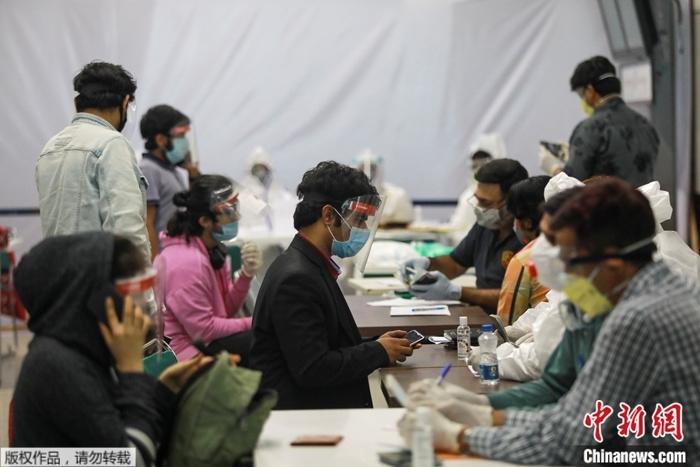(Fighting against New Coronary Pneumonia) International Review: The epidemic is accelerating
China News Agency, Beijing, June 11 Question: International Review: The epidemic is accelerating, and it is not easy for India to want to "untie"
Author Zhang Shuo
Although India has announced the extension of the national blockade measures being implemented until June 30, it also clarified the difference between strict blockades in strict control areas and the gradual liberalization of non-strict control areas. How to restore the economy while containing the epidemic has become this The biggest test for the country with the second largest population.
On May 25, at the Shiraz International Airport in Mumbai, India, security personnel checked passenger identity information.
This round of policy is the fifth round after India opened the "national blockade" on March 25. Its obvious change is to seek a balance between the blockade and "unbonding".
The spread of the epidemic has a huge impact on the Indian economy. The World Bank’s “Global Economic Outlook” report released on the 8th shows that India’s economy is expected to contract by 3.2% in the fiscal year 2020-2021, down 9% from its forecast in January this year. Bloomberg quoted the research institute CRISIL's forecast as saying that the Indian economy may take at least 3 years to recover to 2019 growth levels.
The blockade policy also brought about a high unemployment rate. According to data released by the Indian government on the 1st of this month, the unemployment rate in the country has risen to 23.48% in May. According to estimates by the Indian Economic Monitoring Center, about 122 million people were unemployed in India in April alone.
In addition to epidemic prevention and control, there is also the threat of natural disasters in front of India. According to the "Indian Express" report, the strong storm "Nisagar" landed near Mumbai City on the 3rd with strong winds and heavy precipitation. About 100,000 people were transferred from Maharashtra and Gujarat. In addition, the locust disaster since May It has brought great damage to many cities and farmland, and is considered to be the worst locust plague in India in the past 30 years.
India under multiple pressures has been trying to resume production. The reporter sorted out and found that in April, India had allowed to resume work in the fields of agriculture, manufacturing, and engineering construction under the guidance of administrative measures. On May 12, it launched another economic stimulus plan to stabilize employment, with a total value of about 264.4 billion US dollars; On May 25, domestic domestic passenger flights were resumed.
In the eyes of many Indian economic circles, it is now the most suitable "unbonding" node, because once this time is exceeded, the Indian social economy and people's psychology will be more unbearable. Rajan, the former president of the Bank of India, said more bluntly that control should be relaxed at the end of April.
The picture shows India under the epidemic.
So, do ideals shine into reality, or "ideals are full and reality is skinny"?
According to the policy of non-strict areas, on June 8th, under the premise of maintaining social distance, religious places, hotels, restaurants, shopping centers, etc. in India are allowed to be opened to the public. But also on this day, India has added nearly 10,000 new cases of coronary heart disease.
In fact, since June, the number of newly diagnosed cases of new coronary pneumonia in India has not declined but has risen. Once in 7 days, the number of newly confirmed diagnoses in a single day has continuously refreshed the record. As of the 11th, the cumulative number of diagnoses in India has reached 2,86579 cases, second only to the United States, Brazil, Russia, and the United Kingdom.
The epidemic has accelerated, making the timing of the "unbonding" questionable. WHO officials said earlier that India's blockade measures have helped to reduce the spread of the epidemic, and relaxation of control may increase the risk of transmission. In addition, some Indian politicians and health experts also expressed concerns. Randip Guleria, director of the All India Institute of Medical Sciences, previously predicted that the peak of India's epidemic may be a month later. Many Indian media believe that the cumulative number of confirmed cases in India will exceed 300,000.
On the one hand, there are a growing number of confirmed cases, and on the other, the economic index, which is seriously declining. Under the left and right, India has made a decision of strict and non-strict management. It remains to be seen how effective it is. For this big South Asian country, a new round of challenges has just begun. (Finish)

